Polyphagous shot-hole borer
Introduction
Polyphagous shot-hole borer, PSHB (Euwallacea fornicatus) is a tiny exotic wood boring beetle native to south-east Asia (Figure 1). The beetle is highly invasive, attacking a wide range of both healthy and dead or dying trees. It burrows into tree trunks and branches where it lives in association with an ambrosia fungus that can cause infection of the plant tissues (Figure 1). Eventually the beetles chew their way out of the wood to find a new host, producing shot holes in the tree.
In 2003, the beetle was detected in California and has since spread to Hawaii (2007), Israel (2009), South Africa (2017) and Palestine (2019). All incursions have proved challenging to manage. The impact has been predominantly in urban environments but there has been some cross-over into agriculture and natural ecosystems.
In 2021, PSHB was detected for the first time in Australia in a Box Elder Maple tree in East Fremantle, Western Australia and has since been found throughout the Perth metropolitan region. Western Australia is currently undertaking an extensive management and eradication program.
Polyphagous shot-hole borer is not present in Victoria
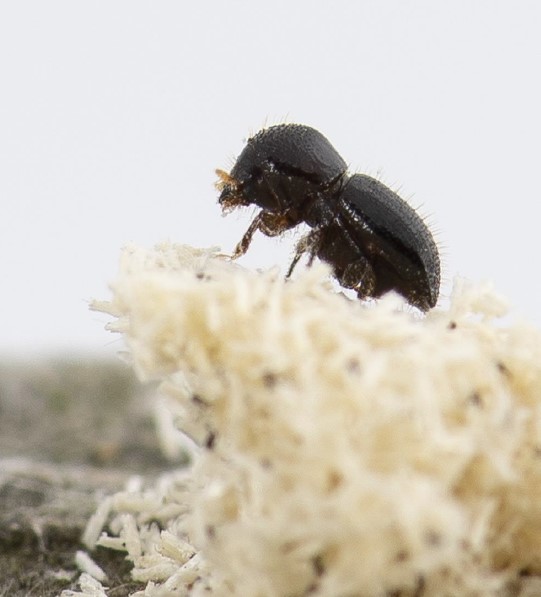
PSHB life history
PSHB female beetles are slightly less than 2 mm long or about the size of a sesame seed (Figure 2) Males are even smaller, around 1.6 mm. he egg, larvae, pupa and male adult spend their entire life within the tree. Only the females disperse to new hosts where they penetrate the wood to lay 20-50 eggs. Development time from egg to adult usually takes 30 to 40 days but can be shorter in hot weather (22 days at 24 °C). A female is able to produce males from unfertilised eggs and is able to start a whole new colony on her own.
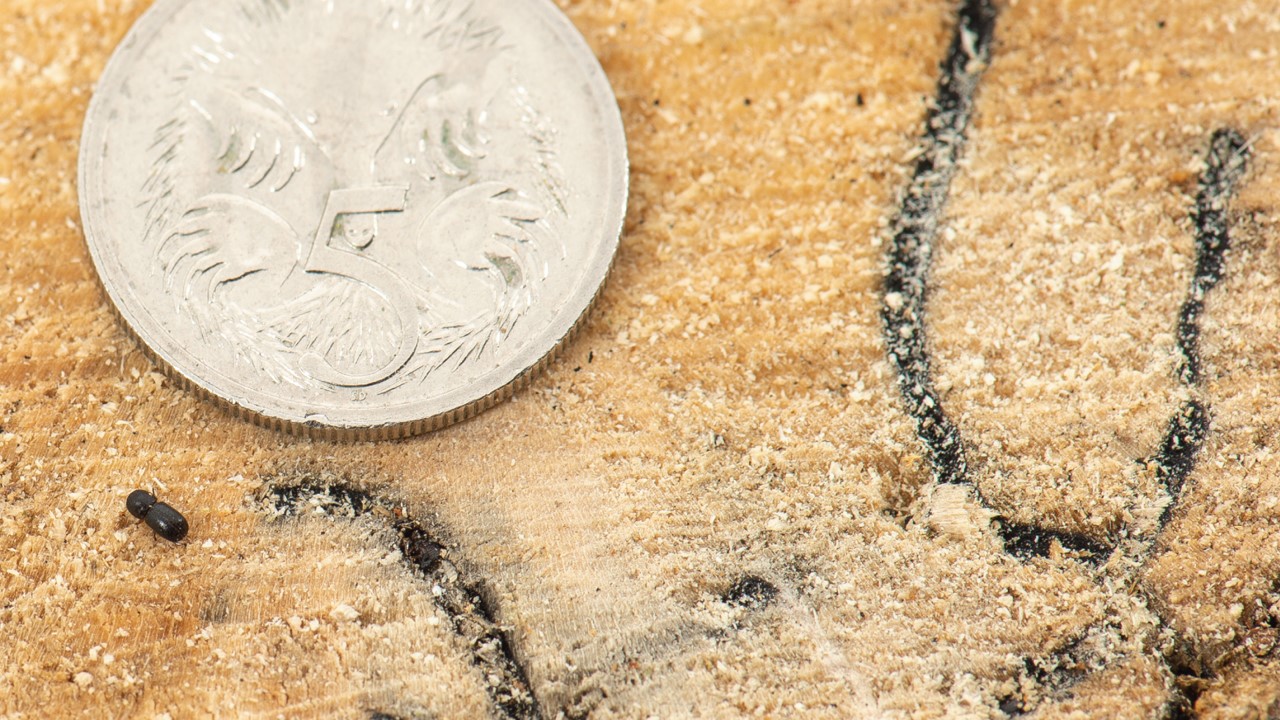
Relationship with the ambrosia fungus
The beetle has a close, mutually beneficial relationship with the ambrosia fungus which it cultivates as a food source. Fusarium euwallaceae is the most commonly associated ambrosia fungal species discovered in association with PSHB. However, in Australia the beetle is associated with an unnamed species, Fusarium sp. [AF-18], which means any potential impacts may vary from overseas experience.
PSHB have small sacs in their mouth which store the spores of the fungus. Once the beetle has bored its way into a tree, it creates pathways (called ‘galleries’) within the branches and trunks of the tree (Figure. 3). The fungus is planted in these galleries and left to germinate and grow.
PSHB and the Fusarium fungus cannot survive without each other. Without the fungus, the beetle does not have a food source. Without the beetle, the fungus has no way of being transported to different places within the tree or new hosts. Combined, the two species cause branch dieback and tree death by disrupting the plants vascular system and flow of water and nutrients (Figure 4).
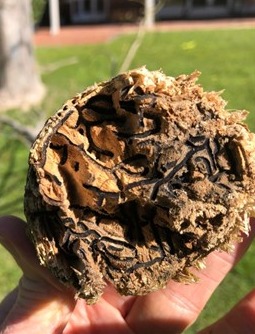
Host trees
The PSHB has a host range of more than 600 tree species.
Trees in which the beetle is able to complete its life cycle (‘reproductive hosts’) are preferred and are more likely to be heavily damaged through infestation. In California, South Africa and Israel the Box Elder Maple tree (Acer negundo) has been observed as the highest risk reproductive host.
Western Australia has identified the Box Elder Maple (Acer negundo) and the Black Locust (Robinia pseudoacacia) as its two highest risk host trees.
Other high risk reproductive hosts found in WA include:
- coral tree (Erythrina x sykesii, Erythrina spp.)
- Morton Bay fig (Ficus macrophylla)
- Port Jackson fig (Ficus rubiginosa)
- London plane (Platanus x acerifolia)
- white mulberry (Morus alba)
- black mulberry (Morus nigra)
- poinciana (Delonix regia)
- mirror bush (Coprosma repens)
Trees inhabited by the beetle but do not support beetle reproduction (‘non-reproductive hosts’) can often tolerate PSHB damage. The fungus does not thrive or become established in these trees.
What to look for
Tree monitoring plays an important role in the early detection of PSHB, which is vital in any eradication program. Unfortunately, the beetle’s size and habit of spending most of their life inside the tree makes them hard to spot. There are, however, a few symptoms to look for which indicate the beetle could be present.
With an established infestation you will see multiple entrance holes (shot holes) on the trunk or branches that are approximately the size of a ballpoint pen tip (0.85 mm in diameter) (Figures 5 and 6).
The occurrence of frass (fine powdery refuse produced by the boring insects) on the trees indicates the presence of the insect activity (Figure 7).
Noodles, which are thin tubules of compacted frass emerging from shot holes, are often a sign that the tree is heavily invested (Figure 8).
Gumming is caused by excessive thick resin or sap being pushed out of the shot holes. In the process the sap can push the beetle out of the gallery, aiding the monitoring process (Figure 9)
Discolouration or staining of the outer bark around the shot holes is caused by resin (Figure 10).
Sugar volcanoes are caused by the trees response to the disruption of the vascular system by the borer. A sugary substance is exuded from the entry and exit holes. As it dries it forms a white crystalline ring around the shot hole (Figures 11 and 12). Sugar volcanoes are common on avocado trees overseas.
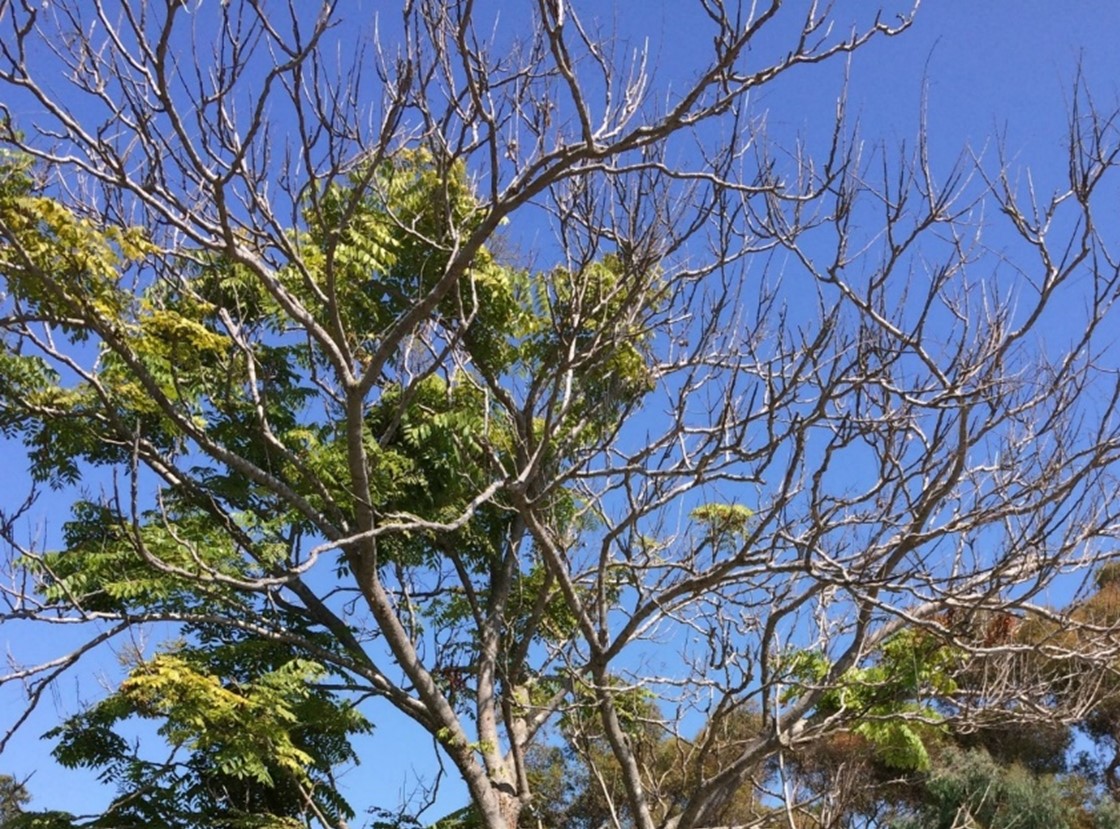
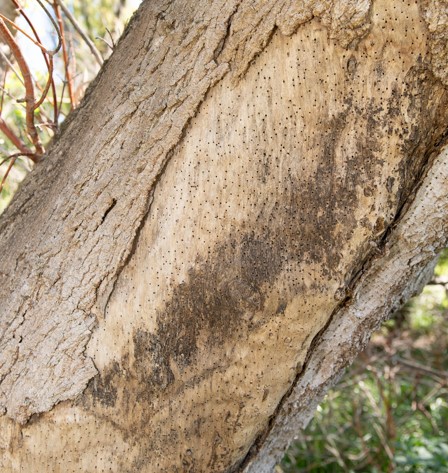

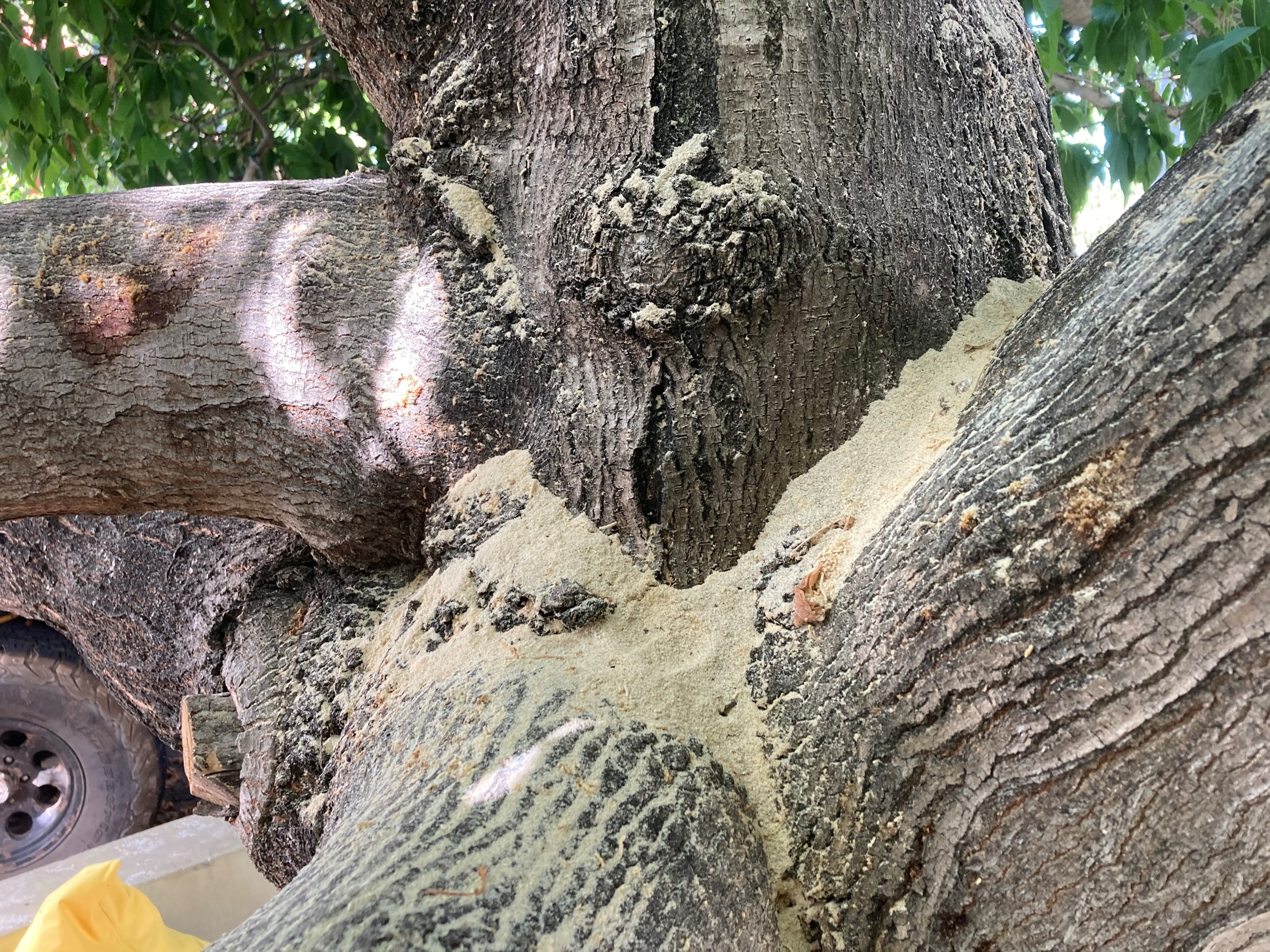

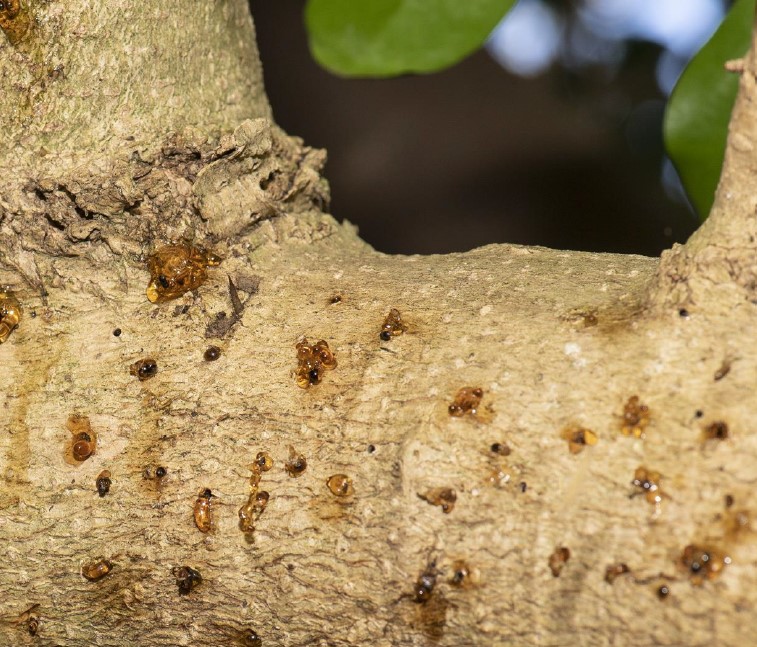
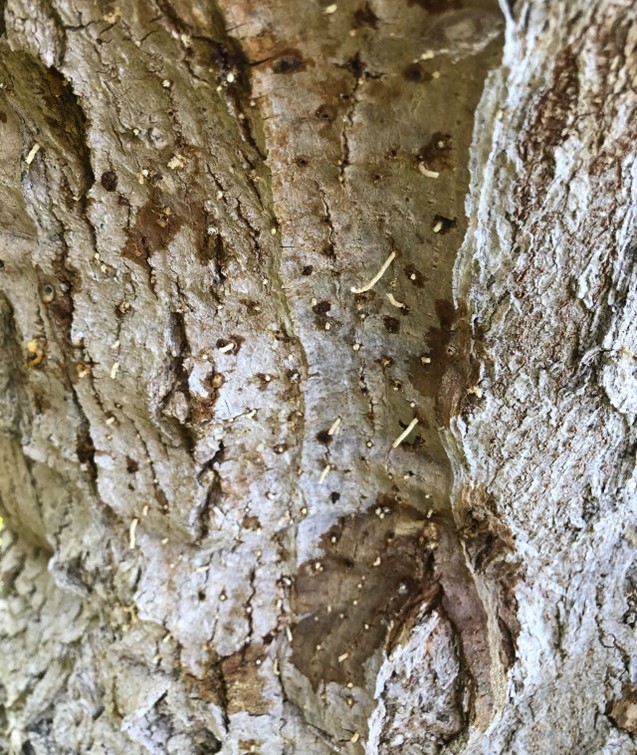


Impact of PSHB
Many recorded hosts are commonly planted as street, amenity and ornamental trees or are established, often iconic, trees gracing city parks and botanic gardens. Large scale removal of such trees is likely to be socially unacceptable as the trees provide significant advantages, particularly in an urban setting. Such benefits include aesthetics, noise and air pollution mitigation and maintenance of biodiversity. Removal of street trees would also negatively affect house prices and increase home heating and cooling costs. In California and South Africa serious damage to urban trees from PSHB infestation has raised concerns about public safety.
In a commercial setting, the beetle has emerged as a damaging pest of avocado in Israel. Predominantly non-reproductive hosts from the nursery, forestry and fruit and tree nut industries, can become heavily infested when the reproductive host population is saturated.
The presence of the beetle will also have an impact on internal markets affecting movements of wood and plants for planting. PSHB can be present in trunks and branches as small as 2.5 cm in diameter resulting in restrictions of the movement of woody plants in the nursery trade.
How does PSHB spread?
Long-distance spread of PSHB is facilitated by movement of infested plants and plant products.
Any trees with branches greater than 2.5 cm in diameter could harbour the beetle and move it to a new location. PSHB has also been found in wood, wood products and untreated wood packaging materials (pallets, dunnage, crates) and can be spread via long haul transport.
The beetle has the ability to survive in felled wood for many months. Firewood, green waste and woodchips larger than 2.5 cm should not be moved around.
Female beetles can fly and average of approximately 40 m and will naturally disperse into the immediate environment when seeking new host trees.
Management of PSHB
There is no known effective chemical treatment for the extermination of PSHB. As the beetle spends almost its entire life hidden in galleries, insecticides have a limited efficacy. The biology of beetle also makes it a challenging candidate for biological control.
Controlling the spread of the beetle is best managed by removal of heavily infested reproductive host trees, pruning of infested branches and continued monitoring round high impact sites.
What should I do if I think I have found PSHB?
If you think that you have found PSHB and/or PSHB symptoms report them immediately to using the Agriculture Victoria public online reporting form or contact the Exotic Plant Pest Hotline 1800 084 881.
Take clear photographs of the tree symptoms and beetles, if you can find them, and upload them with your report. Good quality photos are important for rapid identification which is vital to any eradication program.
Reporting an unusual plant insect pest or disease
Report any unusual plant pest or disease immediately using our online reporting form or by calling the Exotic Plant Pest Hotline on 1800 084 881. Early reporting increases the chance of effective control and eradication.
Please take multiple good quality photos of the pests or damage to include in your report where possible, as this is essential for rapid pest and disease diagnosis and response.
Your report will be responded to by an experienced staff member, who may seek more information about the detection and explain next steps.
Report onlinePhoto credits
All photos courtesy of the Western Australian Department of Primary Industries and Regional Development.